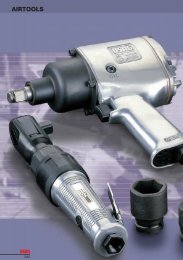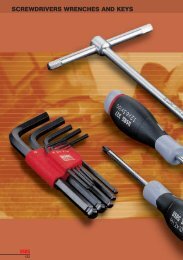Industrial seal self study guide - SKF.com
Industrial seal self study guide - SKF.com
Industrial seal self study guide - SKF.com
You also want an ePaper? Increase the reach of your titles
YUMPU automatically turns print PDFs into web optimized ePapers that Google loves.
BASIC SEAL TYPES (cont.)<br />
A<br />
As a shaft rotates in a stationary<br />
housing, a CRW1 dynamic radial<br />
<strong>seal</strong> both retains lubricant and<br />
excludes contaminants (fig. 2c).<br />
B<br />
Axial mechanical <strong>seal</strong>s create an<br />
interface along the shaft plane<br />
between matched <strong>com</strong>ponents.<br />
Usually, one contact face is stationary<br />
while the other rotates with the shaft<br />
(fig. 2d).<br />
At the “interface” point, a thin film<br />
of lubricant separates <strong>seal</strong>ing surfaces<br />
(fig. 2e).<br />
Dynamic “Radial” Seals<br />
A dynamic radial <strong>seal</strong> creates a barrier or interface between surfaces<br />
in relative motion. For radial lip type <strong>seal</strong>s, the interface is where the<br />
<strong>seal</strong> touches the shaft. Sealing is ac<strong>com</strong>plished by two surfaces making<br />
contact radially, one usually stationary while the other rotates.<br />
An example of a radial <strong>seal</strong> is shown in figure 2c. As the shaft rotates<br />
in a stationary housing, a CRW1 <strong>seal</strong> both retains lubricant and<br />
excludes contaminants. Typical radial <strong>seal</strong> applications include<br />
gearboxes, drives, motors, pumps and speed reducers.<br />
Axial Mechanical Seals<br />
Axial mechanical <strong>seal</strong>s are face type <strong>seal</strong>s which create an axial<br />
<strong>seal</strong> interface between matched, radially mounted <strong>com</strong>ponents. In<br />
operation, one contact face is usually stationary in the housing while<br />
the other moves with the shaft. Sealing pressure is applied in the<br />
axial direction through a spring mechanism. The spring force keeps<br />
the surfaces together.<br />
Axial mechanical <strong>seal</strong>s are generally used where pressure and/or<br />
surface speeds exceed the capabilities of radial shaft <strong>seal</strong>s. Typical<br />
applications are water pumps and most types of pumps used in<br />
chemical processing plants or refineries. Figure 2d is a view of<br />
such an installation.<br />
Other types of axial <strong>seal</strong>s are “non-mechanical” ones, such as V-Rings.<br />
Seal Interface<br />
“Interface” is the point of contact between <strong>seal</strong>ing surfaces (fig. 2e). But<br />
they do not really “contact” at that point, they are separated by a film<br />
of lubricant as thin as 0.00001 in.—a hundred thousandths of an inch.<br />
In metrics, that is 0.25 microns.<br />
The lubricant film prevents rapid wear of the <strong>seal</strong> lip and/or the shaft<br />
surface. But interface tolerances must be precise to keep the lubricant<br />
from leaking. Uncontrolled conditions of run-out must be prevented.<br />
Any misalignment or eccentricity of interfacing surfaces which exceed<br />
acceptable tolerances must be corrected.<br />
6







